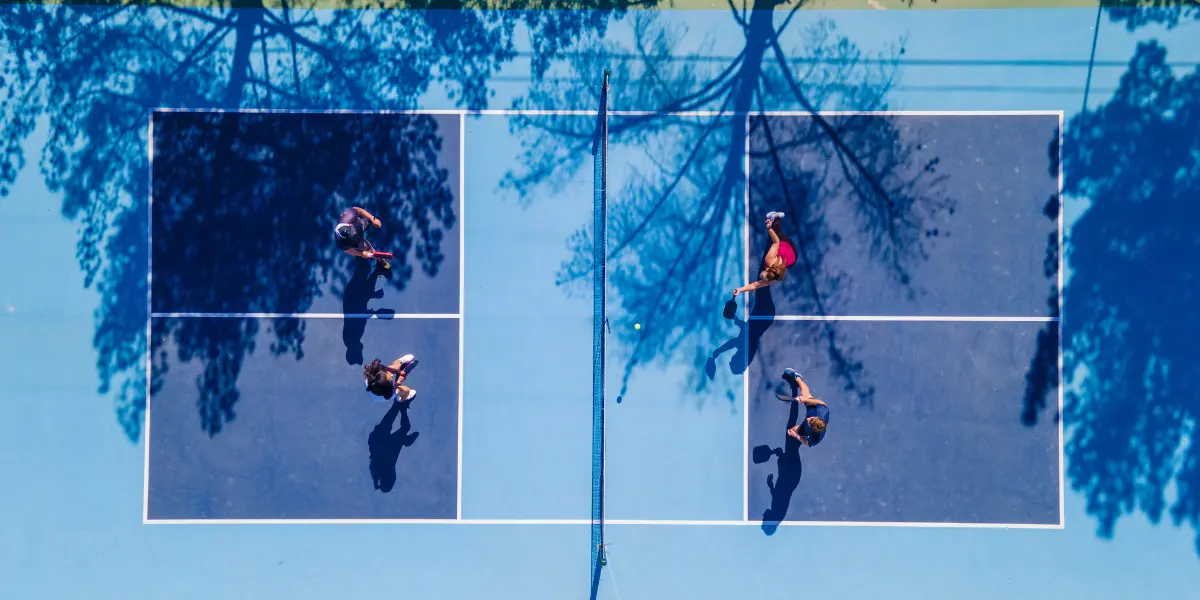Have you ever wondered what pickleball courts are made of and how their surface affects the game? The right court material can make a significant difference in ball bounce, player movement, and overall durability.
Whether you’re planning to build a court, looking to improve your playing experience, or simply curious, understanding pickleball court surfaces is essential.
We will explore different types of pickleball court surfaces, their pros and cons, and which ones are best suited for various playing conditions. Let’s go into the details and find out what makes an ideal pickleball court.
What Is a Pickleball Court?
A pickleball court is a designated playing area measuring 20 feet wide by 44 feet long, making it smaller than a tennis court but similar in layout. It includes a non-volley zone (the kitchen) near the net, ensuring a mix of strategy and movement.
Pickleball courts can be indoor or outdoor, with surfaces varying between hard materials like concrete or asphalt and softer options like modular tiles or clay.
Each material affects gameplay, ball speed, and player comfort, making surface selection an important factor for both recreational and competitive play.
What Are Pickleball Courts Made Of?
Pickleball courts are primarily constructed from materials like asphalt, concrete, and modular tiles, with additional options such as acrylic coatings, clay, artificial turf, and wooden gym floors.
Each surface impacts the game’s speed, ball bounce, and player comfort. Outdoor courts commonly use asphalt or concrete due to durability, while indoor courts favor modular tiles or wood for better shock absorption.
7 Different Types of Pickleball Court Surfaces
Asphalt Pickleball Courts
Asphalt is a popular choice for outdoor pickleball courts due to its durability and affordability. It provides a hard and fast-playing surface, making it ideal for competitive games. However, over time, asphalt can develop cracks due to weather changes and heavy usage. Proper maintenance, such as sealing and resurfacing, can extend its lifespan.
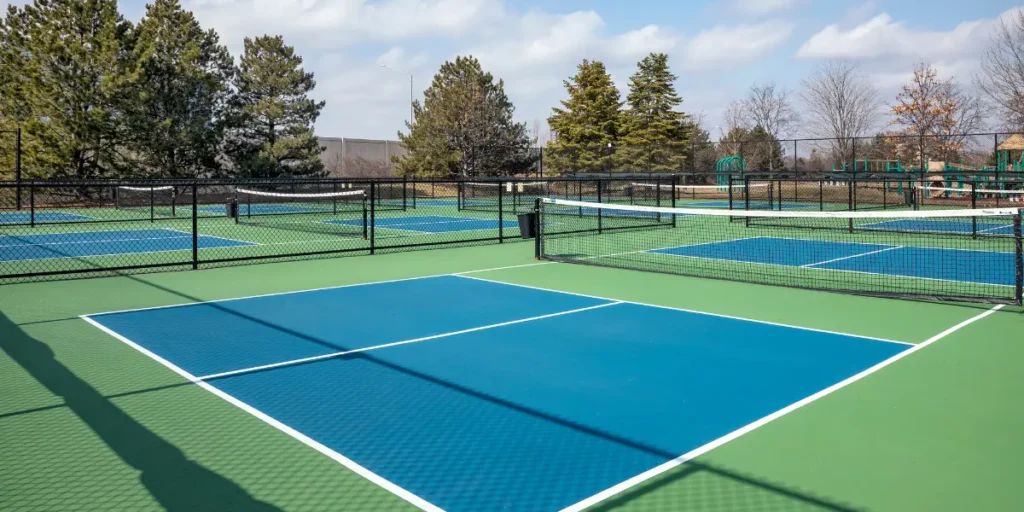
- Pros: Long-lasting, weather-resistant, smooth surface.
- Cons: Can develop cracks over time, and requires sealing.
- Best for public courts and community centers.
Concrete Pickleball Courts
Concrete is another common material for pickleball courts, known for its strength and longevity. It requires minimal maintenance compared to asphalt and does not degrade as quickly. However, its hardness can be tough on players’ joints, so many concrete courts are coated with an acrylic layer to improve cushioning and traction.
- Pros: Hard, durable, lower maintenance than asphalt.
- Cons: Can be hard on joints without proper cushioning.
- Best for: Competitive play, private courts.
Acrylic-Coated Pickleball Courts
Acrylic coatings are often applied to asphalt or concrete courts to enhance their performance. This surface improves traction, aesthetics, and bounce consistency. Different textures can be used to control game speed and ball movement, making acrylic-coated courts a top choice for professional and club-level play.
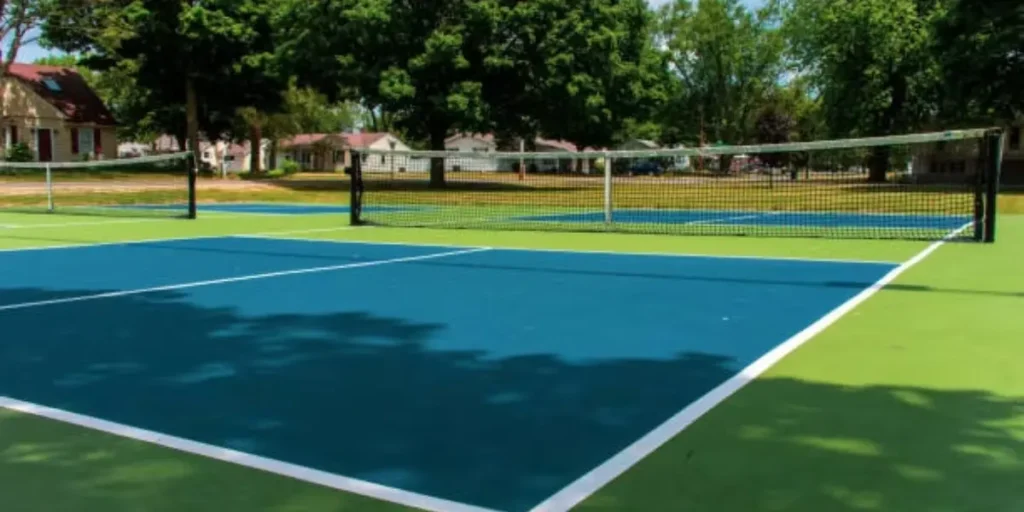
- Pros: Enhances traction, aesthetics, and bounce consistency.
- Cons: Requires periodic resurfacing.
- Best for: Professional courts, club play.
Clay Pickleball Courts
Clay courts are less common for pickleball but are used in some regions. They provide a softer playing surface, reducing strain on joints and offering a slower-paced game. However, they require frequent maintenance, as clay is affected by weather conditions like rain and wind.
- Pros: Softer surface, reduces joint strain.
- Cons: High maintenance, weather-sensitive.
- Best for: Recreational players, senior-friendly courts.
Artificial Turf or Grass Courts
Artificial turf or grass courts are sometimes used for pickleball, particularly in multi-sport areas or temporary setups. These surfaces provide a softer landing and are easier on the knees but can cause unpredictable ball bounces. Regular maintenance is needed to keep the surface level and free of debris.

- Pros: Softer landing, less strain on knees.
- Cons: Unpredictable ball bounce, needs maintenance.
- Best for: Backyard courts, recreational play.
Modular Tiles (Snap-Together Pickleball Courts)
Modular tile courts are made from polypropylene plastic tiles that snap together to create a cushioned playing surface. These courts are used for both indoor and outdoor play, offering excellent shock absorption and reduced risk of injuries. While they provide a great playing experience, they can be expensive and require a flat base for installation.
- Pros: Cushioned feel, reduces impact injuries, easy installation.
- Cons: Expensive, requires a flat base.
- Best for: Indoor facilities, backyard pickleball courts.
Wooden or Gym Floor Pickleball Courts
Wooden courts are commonly found in indoor gymnasiums and multi-purpose sports facilities. They provide a smooth, fast-paced playing experience but can be slippery, requiring proper maintenance. Over time, gym floors need resurfacing to maintain playability.
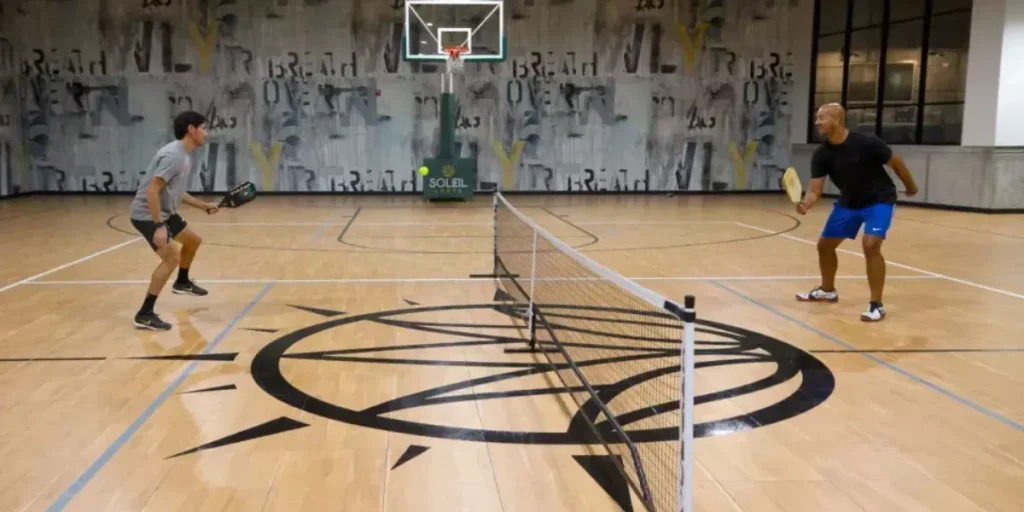
- Pros: Smooth, fast-paced gameplay.
- Cons: Can be slippery; needs resurfacing.
- Best for: Indoor tournaments, school gyms.
Cost Comparison of Different Pickleball Court Surfaces
| Court Type | Initial Cost ($) | Maintenance Cost ($/year) | Lifespan |
|---|---|---|---|
| Asphalt | 8,000 – 15,000 | 500 – 1,000 | 15-20 years |
| Concrete | 10,000 – 20,000 | 200 – 500 | 20-30 years |
| Acrylic-Coated | 12,000 – 18,000 | 500 – 1,000 | 10-15 years |
| Clay | 15,000 – 25,000 | 1,000 – 2,000 | 5-10 years |
| Artificial Turf | 10,000 – 18,000 | 500 – 1,500 | 5-10 years |
| Modular Tiles | 15,000 – 30,000 | 200 – 500 | 15-20 years |
| Wooden Floors | 20,000 – 40,000 | 1,000 – 2,500 | 10-15 years |
The choice of surface depends on factors such as budget, maintenance requirements, and long-term durability. While concrete courts have a higher initial cost, they require less maintenance and have a longer lifespan compared to other surfaces.
Which Surface Is Best for You?
Choosing the best pickleball court surface depends on factors like budget, climate, and player type. If you are looking for an outdoor court, asphalt and concrete are ideal due to their durability and weather resistance. For indoor courts, wooden or modular tile surfaces provide excellent traction and comfort.
- Best for Beginners: Acrylic-coated surfaces offer a good balance of durability and playability.
- Best for Seniors: Modular tiles or clay courts reduce joint strain and provide a softer playing surface.
- Best for Competitive Players: Concrete or asphalt with an acrylic coating ensures consistency and speed.
By considering these factors, players can select the most suitable surface for their needs.
How to Prepare the Ground for a Pickleball Court?
A solid foundation is essential for a high-quality pickleball court. The first step is choosing the base material, with concrete and asphalt being the most common options due to their durability.
Next, the ground must be leveled and compacted to ensure a smooth playing surface. Once the base is set, a curing period is necessary, especially for concrete and asphalt, to allow the material to settle properly.
Finally, after the surface is fully prepared, the court lines should be measured and painted according to official pickleball standards. Proper preparation guarantees a long-lasting and professional-grade court.
Pickleball Court Maintenance Tips
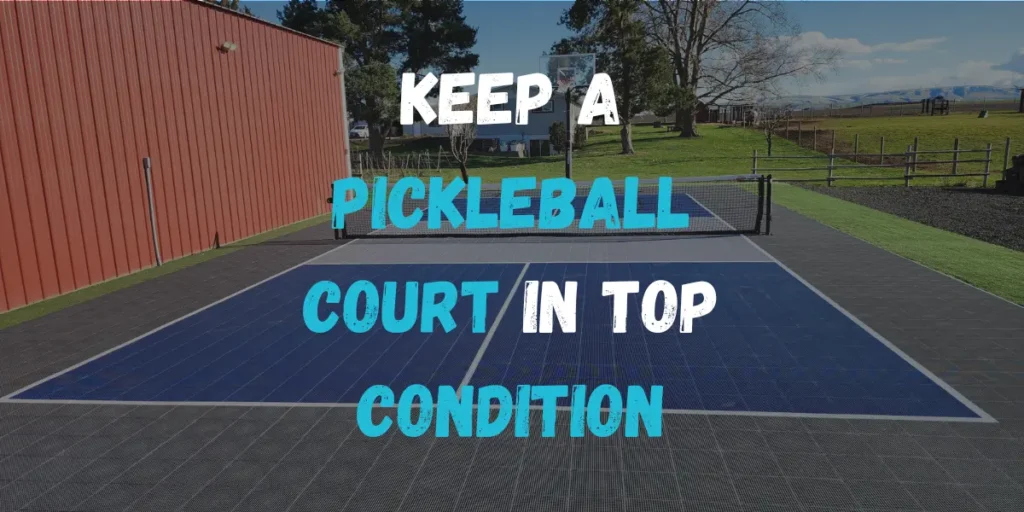
Regular maintenance is essential to keep a pickleball court in top condition. Sweeping the surface regularly helps remove dirt, leaves, and other debris that can interfere with gameplay.
Acrylic-coated and asphalt courts require resurfacing from time to time to maintain their smoothness and prevent wear. Additionally, cracks in asphalt and concrete courts should be sealed immediately to avoid further deterioration.
Outdoor courts need extra care, especially after extreme weather conditions, to ensure they remain safe and playable. Proper upkeep enhances the court’s durability and provides a consistent playing experience for all users.
How to Build a Pickleball Court at Home?
Building a pickleball court at home requires careful planning and the right materials. First, choose a level space, preferably with a concrete or asphalt base for durability.
Next, mark the dimensions of a standard pickleball court (20 feet by 44 feet) and apply surface coatings to enhance traction.
Installing a net system and painting the appropriate court lines ensures proper gameplay. If a permanent court isn’t feasible, modular tiles or portable nets offer flexible alternatives for a backyard setup.
FAQs
The best surface depends on usage and location. For outdoor courts, concrete or asphalt with an acrylic coating provides durability and consistent bounce. Indoor courts often use modular tiles or wood flooring for better comfort and shock absorption.
Yes, a flat driveway can be used as a pickleball court. Temporary lines can be marked using tape or chalk, and a portable net can be set up. However, the bounce may be inconsistent depending on the surface quality.
Concrete is considered the most durable surface for pickleball courts, lasting 20-30 years with minimal maintenance. Adding an acrylic coating improves traction and extends the court’s lifespan.
Yes, a backyard can be turned into a pickleball court with proper preparation. A level surface, such as concrete, asphalt, or modular tiles, provides the best playing experience. Temporary nets and boundary lines can also be used for a flexible setup.
Yes, you can play pickleball on a basketball court by adding lines and a portable net. However, the surface may be harder than dedicated pickleball courts, affecting ball bounce and player movement.
Conclusion
Choosing the right pickleball court surface is essential for ensuring an optimal playing experience. Different materials like asphalt, concrete, modular tiles, and acrylic coatings each offer unique advantages, depending on factors like durability, maintenance, and player comfort.
Whether setting up a professional court or a DIY backyard space, selecting the appropriate surface enhances the quality of play and extends the court’s lifespan.
By understanding the benefits and drawbacks of each surface type, players and court owners can make informed decisions that best suit their needs.

